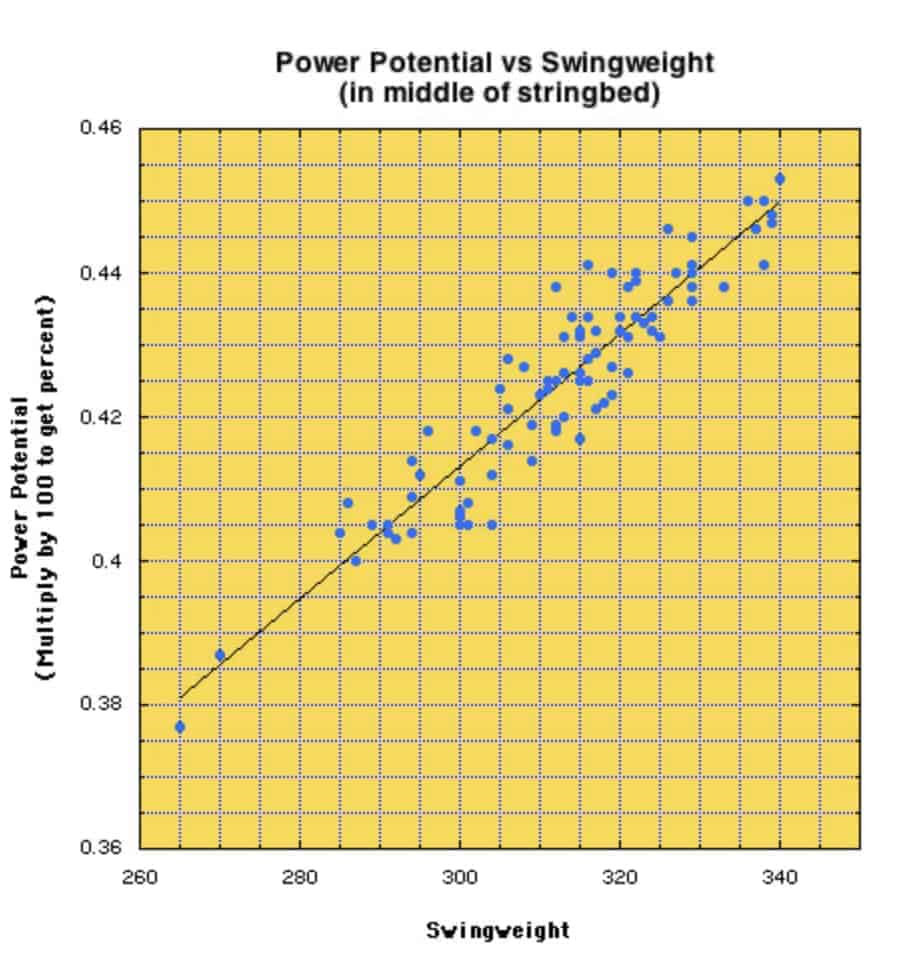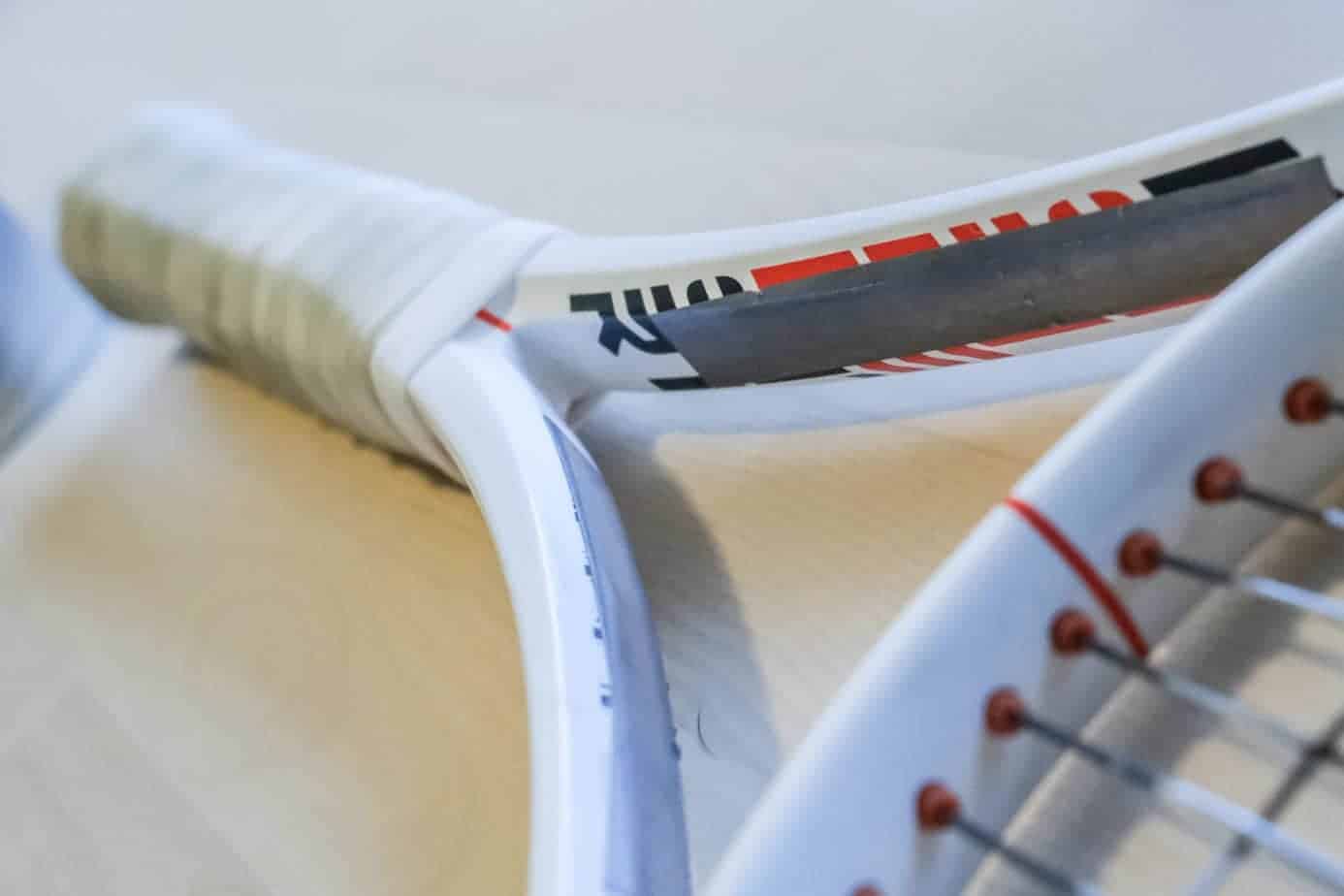When choosing a racket, it is important to understand the specs that are associated with it. This will give you a better idea of how the racket will feel before you even play with it. One of these specs is swing weight, not to be confused with static weight.
The swing weight of a racket is affected by the combination of a racket’s static weight and balance. A racket that is more head heavy will have a higher swing weight than that of a head light racket. Even though these two rackets may weigh the same on the scale, the head heavy racket will feel heavier during play, hence the higher swing weight.
A key to remember is that swing weight is not measured in grams, but rather by a number called RDC (Racket Diagnostic Centre). This can get confused with the measurement of grams that static weight is typically taken in. A lot of times swing weight RDC and static weight in grams can be similar, so make sure to know the difference.
There is a lot more to consider about swing weight besides the basic definition above. In this article we will go into a deeper meaning of what swing weight really means, how it will affect the performance of a racket, what swing weight is best for you, the formula used to calculate it, how to change yours.
Tennis Racket Swing Weight Meaning
Before we get into more specifics, we will cover the basics of what swing weight really means. As mentioned above, the swing weight of a racket is the measurement correlated to a combination of balance and static weight. In this measurement, the distribution of the weight has more of an affect on swing weight than the static weight does. A head heavy racket will have a higher swing weight than a head light racket, assuming that the static weights are the same.
The reason for this is basic physics. If the majority of a racket’s weight is located further from your hand, it will have a heavier effect when swung. Think of your hand as the axis. If the weight is closer to the access, it will have a lighter affect.
How does a racket’s swing weight affect the performance?
Now that you understand the basics of what swing weight is, we can get into the fun part: performance. This is the part that matters most to the typical player because everyone wants to know what different rackets will give them, right? The two basic things that swing weight will affect are power and stability.
Power
The trend among rackets is that as swing weight increases, power increases. This is because a high swing weight allows the racket to plow through the ball at contact. Less swing weight behind the ball at contact causes the racket to move more on impact, taking less energy out of the ball.
Remember that when it comes to swing weight, the distribution of weight is more important. So a racket that is head heavy will provide more power, as the weight is further from your hand.
Below is a chart showing the correlation of swing weight to potential power. You can see that as swing weight increases, potential power increases as well. The chart is courtesy of Tennis Warehouse.

Stability vs. Maneuverability
As swing weight increases, stability increases as well. Further, lower swing weights contribute to less stability and more maneuverability. Stability corresponds to how little the racket moves at contact. This relates to power because of the reasons explained above. Lower swing weights contribute to more maneuverability because as the weight will be centered towards your hand, it will be easier to whip the racket around at will.
Maneuverability will be an advantage for quick reflex volleys at the net, but a disadvantage for power on groundstrokes. This is because as the racket moves more at contact, you will lose power. Stability will be an advantage for power and control, but will be a disadvantage for producing racket head speed. Racket head speed is a key factor in creating top spin.
What swing weight fits your game style?
In my experience I have found that players with short, compact strokes benefit from rackets with a higher swing weight. Long strokes benefit from rackets with a lower swing weight.
Players with loopy strokes that produce a heavy ball will generally prefer a racket with a lower swing weight because maneuverability is so essential for their game. The racket head speed that they rely on for their groundstrokes is hard to come by with rackets that are high in swing weight. On the flip side, players that play flat and through the court generally prefer rackets with high swing weights because it gives them more power as the racket ploughs through the ball at contact.
It is important to remember that your preference on whether you are seeking maneuverability or stability is personal. Different players will benefit from different things, and it is important to know what you should be looking for.

Tennis racket swing weight range
Online you will be able to find racket swing weights ranging from 280-420 RDC. RDC stands for Racket Diagnostic Centre, the machine used to calculate swing weight. When you see that a racket has a swing weight of 330 RDC, this means that this is the number that the machine determined for the particular racket’s swing weight. This is not to be confused with grams. Grams are commonly used to measure the static weight of a racket, and these numbers can be very close to each other.
How can I measure a rackets swing weight?
While you can measure swing weight on your own, it will have imperfections due to human error, especially if you are not experienced with the process. We highly recommend that you find a Racket Diagnostic Centre (RDC) machine to measure a racket’s swing weight for the most accurate results. These machines are fairly uncommon, and you’ll most likely have to find one through a local pro shop or a store that practices racket customization.
Because it can be hard to find an RDC machine, there is a way that you can get a close estimate of swing weight using items found around the house. This process is highlighted by Tennis Warehouse, and you can see the step by step guide here.
How can you change the swing weight of a stock racket?
There is really only one simple way to tinker with the swing weight of a stock racket: using lead tape. Lead tape is material used by many advanced tennis players to get their rackets customized to their liking. Lead tape can be added anywhere on the frame to add weight, and the location of the lead tape will affect the swing weight of the racket.
Lead tape that is placed under the grip will increase the static weight without affecting the swing weight much. However, lead tape added to the top of the frame will affect the swing weight of the racket tremendously.
We have an article on everything you need to know about changing the weight of your racket. Click here to check it out: Adding Weight to Your Tennis Racket: A Beginner’s Guide.
Final Thoughts
Hopefully this article cleared up some of your questions about swing weight. It can be aa bit complicated because there is a lot of science involved, but if you stick to the basics in this article you will be just fine.
Our friends at Tennis Warehouse have a great selection of rackets and they make it easy to find exactly what you’re looking for. Click this link to be sent to their racket finder to find the best frame for you!

